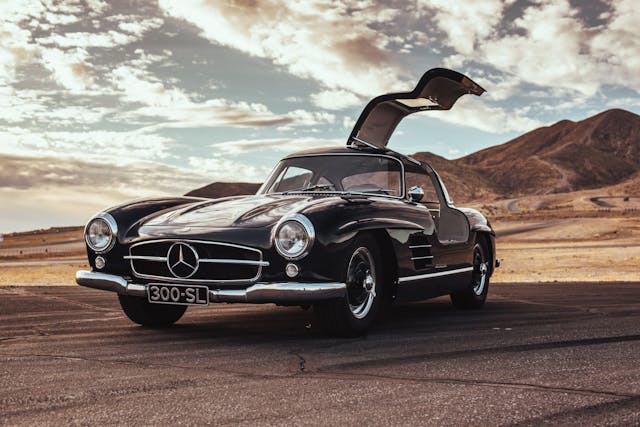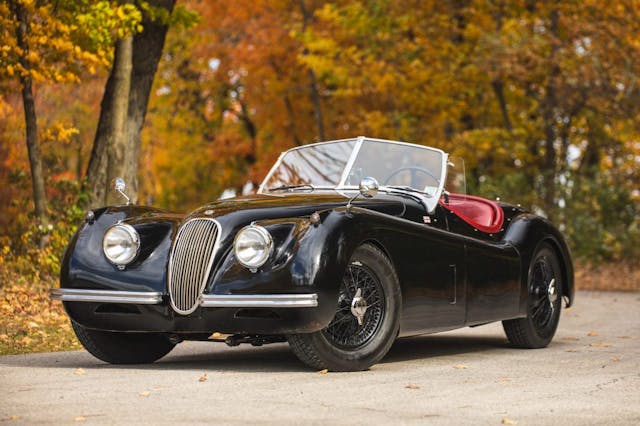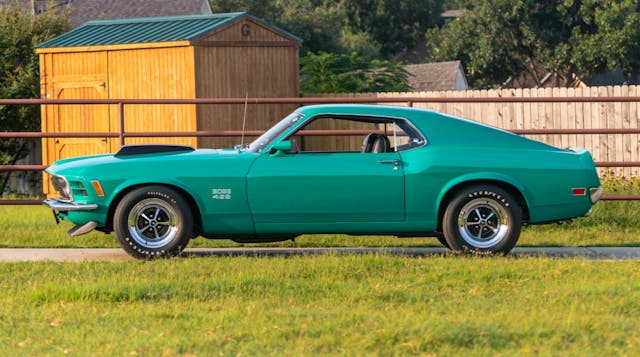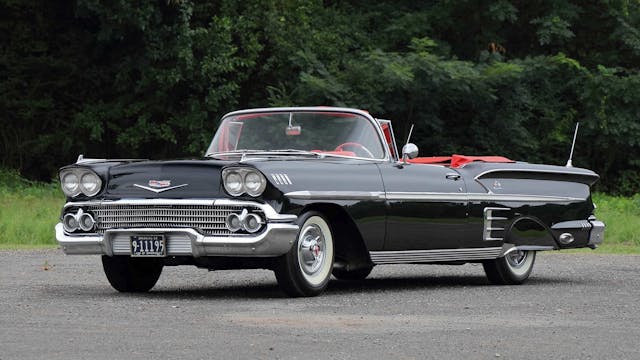The Latest Hagerty Indexes Underscore a Market Reset
The Hagerty Price Guide Indexes—first published in 2009—are a series of stock market-style indexes that average the condition #2 (“excellent”) values of representative vehicles, or “component” cars, from a particular segment. These indexes are updated quarterly and provide an overview of how these segments of the collector car market are performing overall, as well as relative to each other.
Through September of 2024, the collector car market continues to search for its post-pandemic floor, and the latest updates to Hagerty’s collector car indexes illustrate how widespread the current market adjustment is. Of the 11 indexes Hagerty regularly publishes, five have dropped in value since the July 2024 update, while seven held steady. All but four of these indexes are lower than they were a year ago.
Our Muscle Car and Ferrari indexes fell the farthest, with both recording a five percent drop over the last three months. These changes leave the Muscle Car index down 11 percent year over year and the Ferrari index nine percent lower than 12 months ago. The rest of the indexes were either unchanged or down only a small percentage. While the market is more difficult than it has been in the last five years, price retreats aren’t as deep as the quarter’s high-profile auction results suggested.
Blue Chip Index
The Hagerty “Blue Chip” Index of the automotive A-List is a stock market-style index that averages the values of 25 of the most sought-after collectible automobiles of the post-war era.

Hagerty’s Blue Chip index fell one percent last quarter, walking back half of the previous quarter’s gain. Of the 25 cars in the index, three rose in value, eight lost value, and the remainder stood still. August auction results from Monterey and September’s high-dollar European events were weak, but a broader look at market activity among high-end classics demonstrated the decline wasn’t as drastic as casual observers might have believed.
At an individual level, the biggest losses were recorded by the Lancia Aurelia B24 Spider America, which dropped 13 percent, the Bentley S1 Continental drophead coupe, which fell 11 percent, and the Plymouth Hemi Cuda convertible, which slipped nine percent. All these cars were at or near record levels, with this last quarter’s changes bringing them back to 2021 prices.
On the upside, the swiftest riser was the Porsche 356A 1600 Super Speedster (a six percent gain) and the Shelby Cobra 289 (up four percent).
This group of cars will continue to see mixed results as the market settles out. Those models that have a clear ancestral connection to their brand’s current crop of performance cars will likely fare best, while those that don’t will have a harder time earning the attention of the next generation of buyers.
British Car Index
The Hagerty Index of British Cars is a stock market-style index that averages the values of 10 of the most iconic British sports cars from the 1950s-70s.

Hagerty’s British Car index had a quiet third quarter. The overall index was unchanged, with only two of the index’s 10 cars increasing in value and an identical two going down. Over the last year, this index has lost two percent, which could be considered a win given the demographic challenges this market segment is facing.
The Jaguar XK120 roadster was the star car this last period, marking a 14 percent value gain. Despite being regarded as too old-fashioned by a lot of newer collectors, the car’s sultry good looks and visceral experience have been enough to drive its price up by 27 percent over the last year. The index’s other winner was the MGA, which rose by 12 percent. That was more than enough to erase several years of a downward slide. On the negative, the Austin-Healey 100 BN2 Le Mans fell by 11 percent and the Sunbeam Tiger dropped six percent.
These cars continue to chart an uneven path. Objectively, their performance per dollar makes them feel overpriced when compared to more modern choices. But car collecting isn’t an objective exercise, and these models are charming and charismatic. For now, these two forces are largely in equilibrium.
Ferrari Index
The Hagerty Ferrari Index is a stock market-style index that averages the values of 13 of the most sought-after street Ferraris of the 1950s-70s.

Hagerty’s Ferrari index had its roughest quarter since before the pandemic sent the market into overdrive. The group’s five percent fall was its biggest drop since May 2020. Only a single component car increased in value, while seven dropped and five stood still. This year’s Monterey auctions showed clear caution among vintage Ferrari buyers, which extended beyond auctions and carried through September.
Decreases were substantial both in terms of percentages and absolute dollars. The Ferrari 250 GT SWB dropped the most at 14 percent (or $1.1M), while the Ferrari 250 LM lost $2M (10 percent). The Ferrari 250 PF coupe and 250 GT Lusso both shed nine percent. The index’s lone winner was the 330 GTC, which hit its highest value since 2017.
Vintage Ferraris have always been more volatile than the rest of the collector car market, with highs soaring higher and lows sinking lower, and that pattern is repeating itself again. But remember that the Ferrari brand is as strong as ever (current gatekeeping practices aside), and production numbers for all of these Ferrari models are exceptionally low, which should provide a cushion for this current market cycle.
American Muscle Car Index
The Hagerty Index of American Muscle Cars is a stock market-style index that averages the values of the rarest and most sought-after muscle cars.

Hagerty’s American Muscle Car index shared the dubious distinction of being the biggest loser this period along with our Ferrari index. Its five percent fall matched the magnitude of last April’s decrease, leaving the group down 11 percent over the past 12 months. It is now 14 percent off its 2023 high.
Of the 15 cars in this group, eight fell in value and six were unchanged. The sole car to increase was the Chevrolet Yenko Camaro, which moved from $429,000 to $446,000. The Plymouth Hemi Cuda lost $250,000, or a heady nine percent, and the Chevrolet LS6 Chevelle fell eight percent. The downward moves were marque agnostic and widespread enough to conclusively state that the muscle car market is correcting.
German Car Index
The Hagerty Index of German Cars is a stock market style-index that averages the values of 21 of the most sought-after cars from BMW, Mercedes-Benz, and Porsche from the 1950s-70s.

Despite a declining market overall, Hagerty’s German Car index had an uneventful third quarter. The group was unchanged in total, with six cars increasing in value, five cars decreasing, and the remaining 10 holding steady.
Below the surface, some individual cars made notable moves. Porsche 356A Speedsters had big quarterly gains, with the 1600 Super increasing by six percent, and the GS Carrera gaining eight percent. Mercedes-Benz SLs also performed well, with the 280SL rising by seven percent and the 190SL moving ahead by five percent.
These moves were erased by a few Mercedes that didn’t fare well: the 300Sc Cabriolet dropped 11 percent and the 600 Grosser sedan slid seven percent. The biggest loser of the quarter for this group, though, was the 1973 3.0 CSL Batmobile, which plummeted 18 percent.
Those results aside, this set of cars has been one of the most reliable segments of the collector car market for over a decade, and it is continuing to be resilient.
1950s American Car Index
The Hagerty Index of 1950s American Classics is a stock market-style index that averages the values of 19 of the most sought-after collectible American automobiles of the 1950s.

Hagerty’s index of 1950s American Cars had its second consecutive quarter without a change, with five cars increasing in value, four decreasing, and 10 treading water. For more than a decade this segment of the market has hovered around the same value, meaning it has missed out on the major increases that the broader market has experienced. Conversely, this stability also suggests that older eras won’t see their bottom fall out as the core demographic slows down their buying habits.
The biggest winner in the group was the 1954 Buick Skylark, which marked a 25 percent gain, overtaking the 1953 Oldsmobile Fiesta, which fell by 13 percent. The Ford Skyliner fell by double digits (10 percent) as did the Hudson Hornet. This was counterbalanced by the Continental Mark II’s eight percent improvement.
Affordable Classics Index
The Hagerty Index of Affordable Classics is a stock market-style index that averages the values of 13 undervalued cars, priced around $40,000, from the 1950s-70s.

Hagerty’s Affordable Classics index dropped two percent in the third quarter of 2024. It was the first decrease for the group since the first quarter of the year, which leaves the index three percent below where it was 12 months ago.
Only one car, the Volkswagen Karmann Ghia, rose in value (seven percent). Meanwhile, four cars fell and the remaining eight cars were static. The biggest decrease was for the Datsun 240Z, which dropped by a massive 12 percent.
Up until 2022, this segment of the market has recorded steady and substantial gains, quarter after quarter, with an acceleration taking place during the pandemic. The two years since, however, have been quiet. While the index hasn’t seen a correction yet, buyers—even at more affordable levels—are being cautious.
RADindex
The Hagerty RADindex is a stock market-style index that averages the values of 21 collectible vehicles from the 1980s and 1990s.

Hagerty’s RADindex, much like the similarly priced Affordable Classics index, continues to plateau following years of appreciation. This past quarter saw the group record a one percent decrease, and over the last 12 months netted out to a one percent increase.
Leading the way was a massive move by the Mk II Volkswagen Golf GTi, which moved an astounding 40 percent for the quarter. Six other component cars increased as well, but none more than three percent. On the flip side, the Fox-body Ford Mustang 5.0 convertible slid by seven percent, the Ferrari Testarossa dropped six percent, and the Buick GNX skidded five percent.
Long-term prospects here are good, simply because enthusiasts who grew up pining for these cars are still entering the buying pool, and because most cars from this era are still priced within reach of younger buyers.
Truck and SUV Index
The Hagerty Truck and SUV Index is a stock market-style index that averages the values of 18 collectible trucks and SUVs from the 1940s to the 1990s.

Hagerty’s Truck and SUV index was unchanged during the third quarter of 2024, with four of the index’s 19 component vehicles coming down in value, three going up, and the rest sitting on the sidelines. The index is also unchanged over the last 12 months, and 14 percent up over the last three years.
The group’s biggest mover was the Range Rover, which gained eight percent. Land Rover Series IIs walked back nearly all that momentum with a six percent decrease. The Toyota FJ40 recorded a seven percent decline and the Jeep CJ-7 fell five percent.
Trucks and SUVs have climbed relentlessly for more than a decade thanks to their versatility, customizability, and nostalgia. Those tailwinds have quieted down as the market resets, but they aren’t likely to stop blowing altogether in the future.
Japanese Vehicle Index
The Hagerty Japanese Vehicle Index is a stock market-style index that averages the values of 19 collectible Japanese vehicles from the 1960s to the 2010s.

Hagerty’s Japanese Vehicle index clearly shows a pandemic-induced step change in market values for the Japanese segment. The group is unchanged over the last three months and has been essentially flat for two and a half years. Going back five years, however, this index is up an impressive 74 percent.
Four of this group’s component vehicles increased in value last quarter, four fell, and the remaining 11 were unmoved. The standout car was the Honda CRX, which surged ahead 25 percent, while the second biggest move was the Honda S2000’s four percent change. The Datsun 240Z fell farthest, with a 12 percent dive, distantly trailed by the Toyota Land Cruiser FJ40’s seven percent plunge.
Expect further settling ahead for this group, with minor downward adjustments until the broader market finds its floor.
Supercar Index
The Hagerty Supercar Index is a stock market-style index that averages the values of 15 collectible modern supercars and hypercars.

Hagerty’s Supercar index held firm during 2024’s third quarter, which was a small victory considering none of our indexes gained ground. This segment of the market has been remarkably strong over the past decade and is also the biggest gainer over the past year at three percent. Of the index’s 15 component cars, two declined and the rest held steady.
The Bugatti EB110 fell three percent and the Mercedes-Benz SLR McLaren dipped a single percent. Otherwise, all was uncharacteristically quiet in this segment.
These cars have a lot going for them in the market, with scintillating performance, low production numbers, and a wave of aspiring owners coming into their key collecting years. Even as a caution flag waves over the market, these cars are well-positioned to accelerate soon.



Regarding the stratospheric prices for US muscle cars:
Do you want the car or the car’s provenance?
If you want a GT 350 Mustang, you could have one built for less then the cost of an original.
So, do you want bragging rights or a car you can take to the track and have fun?
BTW:
Great article on the Grey Ghost Tempest.
I wen to a number of Trans-Am races at Riverside but don’t recall seeing that car.
I also go the Brian Redman vintage races at Road America and have never seen that Tempest but would love to see it run.
BTW2:
If you want a low cost, high performance vehicle, take a look at sport bikes, both “naked” and full fairing models.
Last April for my 77th birthday, I bought a slightly used Triumph Street Triple 675R, one seriously quick bike.
To put its performance in perspective.
Triumph: 105 hp, a little over 400 pounds wet + my 200 pounds
My friend’s 2015 Aston Martin V8 Vantage has roughly the same power to weight ratio as my Triumph with me on it.
For a performance to dollar ratio, the Triumph wins though the bike’s top speed is listed as 139 mph; the AM is considerably faster.
Note: I’ve riding motorcycles since I was 19.
So far, so good.
I’m not surprised American Muscle is the group with the biggest drop. Still the drop isn’t crazy but the insanity seems to be behind it for now.
Most are still over valued. This is a investment segment that could tank over night on many cars that were not one of one.
One day bread may be more value than these cars. Just look at the depression in 29.
Not doom or gloom but just keeping it real.
I wish more people just enjoyed cars vs making them investments. This prevents many from entering the hobby or owning some great cars that they can no longer afford.
To be honest with the high prices I would just be as happy building a clone.